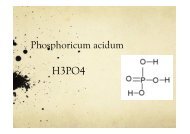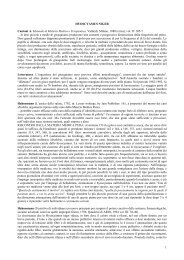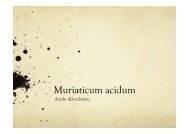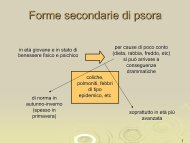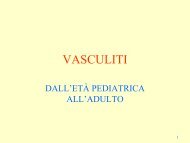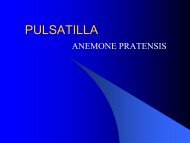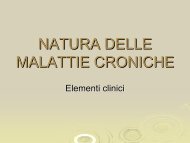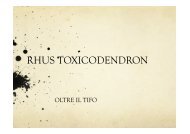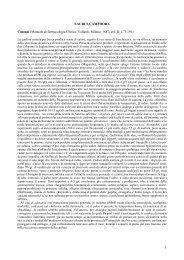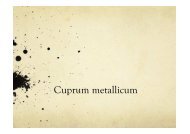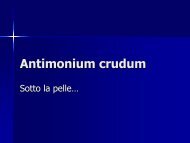omeopatia - OmeoWeb
omeopatia - OmeoWeb
omeopatia - OmeoWeb
You also want an ePaper? Increase the reach of your titles
YUMPU automatically turns print PDFs into web optimized ePapers that Google loves.
IMMUNOFARMACOLOGIA<br />
OMEOPATICA<br />
SPERIMENTAZIONE PURA<br />
nozioni esplicative degli effetti<br />
primari e secondari<br />
1
BASI DI FARMACOLOGIA<br />
• Letteratura scientifica<br />
• Criterio di similitudine<br />
• Uso di potenze ascendenti e discendenti<br />
• Scelta del farmaco unitario, in genere<br />
• Controllo, ove possibile, sul volontario sano<br />
• Verifica clinica<br />
• Sperimentazione clinica auspicabile<br />
2
Complessità di<br />
azioni<br />
farmacologiche<br />
Farmaci<br />
patogenetici<br />
EFFETTI PRIMARI<br />
Citochine<br />
ricombinanti<br />
(struttura) Anti-recettori<br />
Uso delle potenze<br />
omeopatiche, per la<br />
eliminazione degli effetti<br />
secondari<br />
(molecole)<br />
Azioni selettive<br />
3
CRITERIO DI SIMILITUDINE<br />
SINTOMI<br />
STRUTTURA<br />
<strong>omeopatia</strong><br />
MOLECOLE<br />
PATOGENESI<br />
4
RECETTORI AGENTI<br />
INFETTIVI<br />
• siti di legame specifici con proteine estranee<br />
• frequentemente sono molecole di adesione<br />
• a volte con funzioni molteplici<br />
• possono legare diversi agenti patogeni<br />
• coinvolgimento della cellula bersaglio nella<br />
patogenesi della malattia infettiva<br />
• similitudine infettiva per lo stesso recettore<br />
5
RECETTORI AGENTI<br />
Sito di<br />
legame<br />
Agente<br />
infettivo<br />
INFETTIVI<br />
recettore<br />
cellula<br />
bersaglio<br />
6
RECETTORI AGENTI<br />
LPS<br />
Gram-<br />
INFETTIVI<br />
CD14<br />
Monociti/<br />
macrofagi<br />
7
RECETTORI AGENTI<br />
Acidi<br />
teicoici<br />
Gram+<br />
INFETTIVI<br />
CD14<br />
Monociti/<br />
macrofagi<br />
8
Anticorpo antirecettore<br />
ANTI-RECETTORI<br />
recettore<br />
cellula<br />
bersaglio<br />
9
SIMILITUDINE MOLECOLARE<br />
Gram-<br />
LPS Anti-CD14<br />
10
SIMILITUDINE MOLECOLARE<br />
Acidi<br />
teicoici<br />
Gram+<br />
Anti-CD14<br />
11
SIMILITUDINE MOLECOLARE<br />
Siti di<br />
legame<br />
Candida<br />
albicans<br />
Anti-CD11b<br />
12
SIMILITUDINE MOLECOLARE<br />
Siti di<br />
legame<br />
Cytomegalovirus<br />
Anti-CD13<br />
13
SIMILITUDINE MOLECOLARE<br />
Siti di<br />
legame<br />
Rhinovirus<br />
Anti-CD54<br />
14
USO DEGLI UNITARI<br />
NEL CRITERIO DI SIMILITUDINE<br />
MOLECOLARE<br />
15
SIMILE MOLECOLARE<br />
• Candida albicans<br />
• Histoplasma capsulat.<br />
• Leishmania<br />
• Mycobacterium spp.<br />
• Cytomegalovirus<br />
• Coronavirus 229E<br />
• Bacillus thuringiensis<br />
• Gram+ e Gram-<br />
• anti-CD11b<br />
• anti-CD11b<br />
• anti-CD11b<br />
• anti-CD11b<br />
• anti-CD13<br />
• anti-CD13<br />
• anti-CD13<br />
• anti-CD14<br />
16
Candida albicans<br />
leishmaniae<br />
donovani: viscerale<br />
tropicalis: cutanea<br />
brasiliensis: mucocute<br />
Anti-CD11b<br />
Histoplasma capsulatum<br />
monociti<br />
MACROFAGI<br />
myobacteriaceae<br />
17
Anti-CD13<br />
(Zn/metalloproteinasi/aminopeptidasi N)<br />
cytomegalovirus coronavirus 229E<br />
Proteina basica della mielina<br />
monociti/granulociti<br />
Fasi di riacutizzazione<br />
della sclerosi multipla<br />
18
SIMILE MOLECOLARE<br />
• Helicobacter pylori<br />
• Schistosoma mansoni<br />
• Pseudomonas aerug.<br />
• Borreliae<br />
• Haemophil. influenzae<br />
• Neisseria meningitidis<br />
• FHA bordetella pert.<br />
• Campylobacter jejuni<br />
• Proteus mirabilis<br />
• E. coli<br />
• anti-CD15<br />
• anti-CD15<br />
• Anti-CD15<br />
• anti-CDw17<br />
• anti-CDw17<br />
• anti-CDw17<br />
• anti-CDw17<br />
• anti-CDw17<br />
• anti-CDw17<br />
• anti-CDw17<br />
19
Anti-CD15s (antigene sLewis x)<br />
Helicobacter pylori<br />
M-cells<br />
(intestino)<br />
monociti/eosinofili/neutrofili/<br />
eritrociti<br />
Shistosoma mansoni<br />
Pseudomonas aeruginosa<br />
20
Anti-CDw17 (lactosylceramide)<br />
E. coli<br />
Borreliae<br />
Proteus mirabilis<br />
monociti/neutrofili/<br />
piastrine<br />
FHA bordetella pertussis<br />
Haemophilus influenzae<br />
Neisseria<br />
meningitidis<br />
Campylobacter<br />
jejuni<br />
21
LACTOSYLCERAMIDE<br />
Anti-gangliosidi<br />
GM/GD/GT/GQ<br />
20% associati a<br />
malattia celiaca<br />
Neuropatie periferiche<br />
sciatalgia /discopatia<br />
ALS<br />
Oftalmoplegia, atassia, areflessia<br />
GBS<br />
Fysher<br />
syndrome<br />
22
Oncol Rep 2002 Mar-Apr;9(2):267-76<br />
Cancer vaccines: an update with special focus on ganglioside antigens.<br />
Bitton RJ, Guthmann MD, Gabri MR, Carnero AJ, Alonso DF, Fainboim L, Gomez DE<br />
It has been demonstrated that quantitative and qualitative changes occur in ganglioside expression during the<br />
oncogenic transformation. Malignant transformation appears to activate enzymes associated with ganglioside<br />
glycosylation, resulting in altered patterns of ganglioside expression in tumors. Direct evidence of the<br />
importance of gangliosides as potential targets for active immunotherapy has been suggested by the<br />
observation that human monoclonal antibodies against these glycolipids induce shrinkage of human cutaneous<br />
melanoma metastasis. Thus, the cellular over-expression and shedding of gangliosides into the interstitial<br />
space may play a central role in cell growth regulation, immune tolerance and tumor-angiogenesis, therefore<br />
representing a new target for anticancer therapy. The project included two ganglioside based vaccines and one<br />
anti-idiotypic vaccine. We focused on two antigens: first GM3, an ubiquitous antigen which is over-expressed<br />
in several epithelial tumor types; and a second one, N-Glycolyl-GM3 a more molecule, not<br />
being expressed in normal tissues and recently found in several neoplastic cells, in particular breast,<br />
melanoma and neuroectodermal cancer cells. We developed two vaccines, one with each antigen, both using<br />
proteins derived from the outer membrane proteins (OMP) of Neisseria Meningitidis B, as carriers. We<br />
developed also the 1E10 vaccine; an anti-idiotype vaccine designed to mimic the N-Glycolyl-GM3<br />
gangliosides. This monoclonal antibody is an Ab2-type-antibody which recognizes the Ab1 antibody called<br />
P3, the latter is a monoclonal antibody that specifically recognizes gangliosides as antigens. Since 1998 we<br />
initiated a clinical development program for these three compounds. Results of the phase I clinical trials<br />
proved that the three vaccines were safe and able to elicit specific antibody responses. In addition we were<br />
able to demonstrate the activation of the cellular arm of the immune response in patients treated with the GM3<br />
vaccine. Although phase I trials are not designed to evaluate antitumor efficacy, it was encouraging to observe<br />
tumor shrinkage in some patients treated both with the GM3 and N-Glycolyl-GM3 vaccines. We have already<br />
begun a phase II program in several neoplastic diseases, with all three vaccines.<br />
23
Mycoplasma<br />
pneumoniae<br />
Anti-galactocerebroside<br />
Neuropatia periferica<br />
GBS<br />
Fysher<br />
syndrome<br />
Chlamydia<br />
pneumoniae<br />
Anti-ganglioside GM1<br />
24
SIMILE MOLECOLARE<br />
• EBVCA<br />
• EBNA<br />
• HIV gp120<br />
• Plasmodium falcipar.<br />
• HBV vaccino<br />
• Virus influenza A<br />
• Mycobacterium tubercul.<br />
• Poliovirus spp.<br />
• Streptococcus betaA<br />
• Anti-CD21<br />
• anti-CD25<br />
• anti-CD26<br />
• anti-CD36<br />
• anti-CD43<br />
• anti-CD43<br />
• anti-CD43<br />
• anti-CD44<br />
• anti-CD44<br />
25
Anti-CD21<br />
Anti-CD25<br />
B-linfociti/cellule<br />
follicolari dendritiche<br />
T-linfociti attivati/Blinfociti/monociti<br />
EBVCA<br />
EBNA<br />
26
Anti-CD26 (dipeptidyl peptidasi IV)<br />
gp120 HIV<br />
B-T<br />
linfociti/macrofagi<br />
proteasi<br />
Procalcitonina 3-116<br />
Marker<br />
infiammatorio<br />
27
Anti-CD36 (scavenger receptor B)<br />
HCV<br />
Plasmodium falciparum<br />
Simile<br />
molecolare e<br />
patogenetico<br />
Piastrine/monociti<br />
Endotelio/macrofagi<br />
Risposta immunitaria<br />
sugli epitopi comuni<br />
LDL recettore<br />
ox-LDL<br />
Determinanti<br />
autoreattivi comuni<br />
Chlamydia<br />
pneumoniae<br />
28
Anti-CD36 (scavenger receptor B)<br />
Processo<br />
ateromasico<br />
Similitudine<br />
patogenetica<br />
Accumulo di LDL in<br />
soggetti chlamydia<br />
penumoniae +<br />
Ridotta espressione<br />
nella microglia in<br />
Alzheimer, con<br />
accumulo di β-amiloide<br />
29
Anti-CD43 (leukosialin, sialophorin)<br />
HBV<br />
T-linfociti/monociti/granulociti<br />
Mycobacterium<br />
avium, tuberculosis,<br />
bovine (BCG)<br />
Influenza A<br />
30
Anti-CD44 (hermes antigen)<br />
poliovirus<br />
Aggiornamento delle<br />
malattie croniche per<br />
superantigeni<br />
Leucociti/eritrociti<br />
Streptococcus betaemolitico<br />
gruppo A<br />
Molecole di<br />
adesione per<br />
metastasi tumorali<br />
31
SIMILE MOLECOLARE<br />
• HHV-6<br />
• Virus morbillo<br />
• Streptococcus spp.<br />
• Rotavirus<br />
• Coxsackievirus A9<br />
• Hantavirus<br />
• Rhinovirus<br />
• Coxsackievirus A21<br />
• Plasmodium falciparum<br />
• Staphylococcus aureus<br />
• Anti-CD46<br />
• anti-CD46<br />
• anti-CD46<br />
• anti-CD51<br />
• anti-CD51<br />
• anti-CD51<br />
• anti-CD54<br />
• anti-CD54<br />
• anti-CD54<br />
• anti-CD54<br />
32
Anti-CD46 (MCP)<br />
HHV-6<br />
Streptococcus spp.<br />
Virus morbillo<br />
Fasi di riacutizzazione di<br />
malattie neurologiche<br />
tutte le cellule dotate di<br />
nucleo/piastrine<br />
33
hantavirus<br />
Emorragie<br />
renali<br />
Anti-CD51 (integrina)<br />
piastrine/megacariociti<br />
/leucociti<br />
coxsackievirus A9<br />
Enterite (Peyer)<br />
34
hinovirus<br />
staphylococcus<br />
aureus<br />
Anti-CD54 (ICAM-1)<br />
plasmodium<br />
falciparum<br />
coxsackievirus A21<br />
tutte le cellule<br />
35
SIMILE MOLECOLARE<br />
• Echovirus<br />
• Adenovirus spp.<br />
• Rotavirus<br />
• Coxsackievirus B<br />
• Trichomonas vaginalis<br />
• HCV<br />
• HBV<br />
• anti-CD55<br />
• anti-CD55<br />
• anti-CD55<br />
• anti-CD55<br />
• anti-CD71<br />
• anti-CD81<br />
• anti-CD81<br />
36
Anti-CD55 (DAF: decay<br />
accelerating factor)<br />
adenovirus coxsakievirus B echovirus<br />
Tutte le cellule<br />
IDDM<br />
rotavirus<br />
37
Anti-CD71 (recettore transferrina)<br />
Trichomonas<br />
vaginalis<br />
vettore<br />
mycoplasmi<br />
Leucociti<br />
attivati/macrofagi<br />
38
Anti-CD81 (TAPA1: target<br />
antiprolipherative antibodies)<br />
HCV HBV<br />
Linfociti B<br />
39



